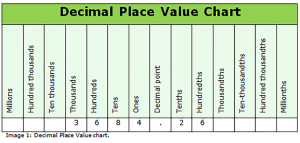2 Place Values
A decimal represents a part or fraction of a whole number. Decimal numbers are parts of 10s, 100s, 1,000s and so on. The decimal point represents the boundary between whole numbers and decimal numbers.

Look at $3,684.26 as an example. We know this amount to be three thousand, six hundred eighty-four dollars and twenty-six cents. The decimal point is the and if we write the number in words. Any number to the left of the decimal point is always a whole number, and any number to the right of the decimal point is a decimal number. Without a whole number, a decimal number is always less than 1. As an example, 0.98 and 0.321 are less than 1.
When absolute precision is not required, it may be helpful to round whole numbers to the nearest ten, hundred, or thousand. For example, bakery tissues come in boxes of 1,000. If you want to keep 3,000 in stock and you find that there are two boxes unopened boxes and one opened box on the shelf, you would order another box of 1,000. This would be easier than counting each tissue to find out that there are 2,245. By rounding to the nearest thousand, you would find that you had approximately 2,000 tissues on the shelf and you would need to order 1,000 more.
When rounding numbers, you first need to decide what place you will need to round to; the nearest ten, hundred, thousand and so on. Once you determine the place, look at digit immediately to the right of the place being rounded. If the digit is 5-9, round the digit to its immediate left up one. If the digit is 0-4, leave the digit to its immediate left the same. Then change all digits to the right to zeros.
Example: Round 87 to the nearest ten.
By going to the place to the immediate right of the tens place, we see that the digit is “7”, we should round the digit to the immediate left up one. Round the “8” in the ten’s place up one, making the number “90”.
Rounding to a specific decimal place is accomplished in the same way that whole numbers are rounded.
Here is an example:
Round 1.85 to the nearest tenth.
Step 1: Underline the place value which you are rounding
1.85
Step 2: Outline (bold) one number to the right of the underlined number. If the outlined (bolded) number is 5 or greater, add 1 to the underlined number and drop all numbers to the right of the changed number.
1.85 → 1.9
If the outlined (bolded) number is less than 5, do not change the underlined number, but drop all the numbers to the right of that number.
1.83 → 1.8
Let’s do one more example:
Round 4.67 to the nearest tenth.
Step 1: 4.67
Step 2: 4.67 4.67 Add 1 to the 6 = 4.7
Note: In this class (after this lesson) you will always round answers to the nearest hundredth unless otherwise instructed. To do that, you first have to determine where the hundredths place is, shown in red below. The next place over, in green, and beyond that, will drop out. The hundredths place number will either stay the same or increase by one. It is the number in the thousandths place, in green, that determines that. If the number in green is 0-4, the number in red stays the same. If the number in green is 5-9, the number in red increases by one.
4.367 → 4.37
0.211 → 0.21
21.0175 → 21.02
6.195 → 6.20
4.497 → 4.50
Notice for the last two, you add 1 to the 9 and it carries over to the next place. You would keep the 0 in this case.
Assignment
Purpose
To practice rounding numbers to different useful places.
Outcomes
By completing this assignment, you will be able to…
- Identify which place the problem is calling you to round to.
- Correctly round numbers to the given place.
Instructions
To complete this assignment…
- Read the problems carefully and find the correct answers.
- Be sure to show how you set up each problem. (In this case, you can circle the number you are rounding to and underline the following number, or whatever works to clearly show how you are reasoning through these problems.)
Tips for Success
To help in the completion of this assignment, make sure to:
- Read each problem carefully and understand what it is asking.
- Include how you set up each problem in order to get credit.
Place Values Assignment
Round to the nearest hundred
1. 1,254
2. 453
3. 989
4. 109
5. 457
Round to the nearest thousand
6. 45,932
7. 43,212
8. 3,454
9. 56,543
10. 191,038
Round to the nearest tenth:
11. 6.74
12. 249.86
13. 0.78
14. 3.612
15. 25.02
16. 704.95
17. 0.0943
18. 349.37
19. 9.89
20. 0.087
Round to the nearest hundredth:
21. 17.327
22. 0.975
23. 4.8166
24. 0.0650
25. 0.0074
26. 2,104.399
27. 32.651
28. 9.27194
29. 46.085
30. 4.719

